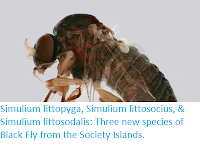Big-headed Flies, Pipunculidae, are True Flies, Diptera, that gain their name from their large eyes, which cover most of their heads. Adult Big-headed flies feed on Honeydew, a sugary secretion produced by Aphids, but the larvae are parasitoids, maturing inside the bodies of other Insects (typically Crane Flies or Leafhoppers), which they consume from the inside as they grow. Because of this habit they are considered to be potentially useful biocontrol agents for Insect pest species.
In a paper published in the European Journal of Taxonomy on 26 October 2017, Behnam Motamedinia of the Department of Plant Protection at the University of Zabol, and the Plant Protection Research Department at the South Agricultural and Natural Resources Research and Education Center, Christian Kehlmaier of the Senckenberg Natural History Collections Dresden, Azizollah Mokhtari and Ehsan Rakhshani, also of the Department of Plant Protection at the University of Zabol, and Ebrahim Gilasian of the Insect Taxonomy Research Department of the Iranian Research Institute of Plant Protection, describe two new species of Big-headed Flies from Iran.
The first new species is named Dasydorylas derafshani, in honour of Hossein Ali Derafshan, who collected the specimens from which the species is described. The species is described from three male specimens, collected in Zabol County in Sistan-o Beluchestan Province. These are 3.3-3.7 mm in length, and silvery grey in colour with large red eyes.
Dasydorylas derafshani, male specimen in lateral view. Scale bar is 1 mm. Motamedinia et al. (2017).
The second new species is named Dasydorylas zardouei, in honour of Maryam Zardouei who collected the specimens from which the species is described. The species is described from four male and two female specimens from Kermanshah Province. These are 3.1-3.5 mm in length and are dark grey in colours with orange eyes.
Dasydorylas zardouei, female specimen in lateral view. Scale bar is 1 mm. Motamedinia et al. (2017).
See also...
Follow Sciency Thoughts on Facebook.








